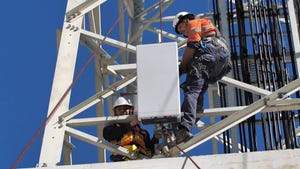Carrier Scorecard: What Recession?
The stalling US economy might be getting ready to take a swing at AT&T, Qwest, and Verizon
May 19, 2008

With landlines continuing to disappear, broadband slowing down, the wireless market becoming saturated, and U.S. economy sputtering, these are scary times to be a telco.
Surprisingly, though, U.S. telcos delivered the goods when it came to shareholder value, as this recent quarter resulted in decent grades handed out on our most recent carrier scorecard.
The longer-term trends aren't looking so cheery, though.
Call it the rule of seven. Since the first quarter of last year, the three U.S. RBOCs have have turned in landline subscriber figures 7 percent lower than the previous year. Verizon Communications Inc. (NYSE: VZ) has led the charge and is making a convincing argument to change it to the rule of eight. The table below illustrates.
Table 1: Landline Losses
1Q07 | 2Q07 | 3Q07 | 4Q07 | 1Q08 | |
AT&T* | n/a | n/a | n/a | 7.4 | 7.7 |
Verizon | 7.1 | 7.8 | 8 | 8.1 | 8.2 |
Qwest | 6.84 | 7.08 | 7.16 | 7.29 | 7.78 |
Figures represent percentage declines from the same quarter a year earlier.*For the first three quarters of last year, AT&T's figures included new assets acquired in the Bellsouth merger that it did not have in 2006, thus reflecting misleading growth in landline subscriber data. |
Eventually the losses will have to flatten, but it's not happening yet; they're accelerating across the board.
Here's some more fun with the numbers. While the loss of landline customers accelerates, broadband growth is becoming less of a hedge against those losses. The chart below illustrates the growth percentage in broadband compared with 12 months earlier. Note how the growth rate has slowed in recent quarters.
Table 2: Declining Broadband Growth
1Q07 | 2Q07 | 3Q07 | 4Q07 | 1Q08 | |
AT&T* | n/a | n/a | n/a | 16.3 | 13.9 |
Verizon | 29.8 | 25.5 | 21.2 | 17.9 | 14.9 |
Qwest | 37.37 | 33.76 | 27.52 | 22.12 | 17.8 |
Figures represent percentage gains from the same quarter a year earlier. *For the first three quarters of last year, AT&T's figures included new assets acquired in the Bellsouth merger that it did not have in 2006, thus reflecting misleading growth in broadband subscriber data. |
Then there's wireless, which has been a star for AT&T Inc. (NYSE: T) and Verizon in recent quarters. But the numbers suggest that their growth could start to stagnate in that sector as well. (See Wireless Growth Slowing?)
Despite all this, the latest scorecard shows some pretty good grades.
Each quarter, Light Reading publishes scorecards on the world's most influential, publicly held carriers, giving each a grade of A through F based on their financial and business performance. Our previous carrier scorecard is right here: Carrier Scorecard: Economic Uncertainty.
Receiving a grade of A is tough. You need to show strong growth across the board and obvious momentum for the future. Since the future looks bleak as of now, no one gets an A this quarter.
Verizon: B+
Consumers don't like it when a carrier raises prices, but accountants and stockholders do. (See Verizon to Raise Prices, Cut Jobs.) That's exactly what Verizon continues to do with FiOS and customers continue to sign up.
But the concern is that Verizon might be focusing on FiOS at the expense of its DSL customer base, which could explain the slowdown in overall broadband. With DSL still holding a significantly larger customer base than FiOS, this could come back to haunt the carrier.
Verizon still showed strong financial growth. It seems unlikely that its FiOS customer base will turn into churn, and it's investing in the wireless future with spectrum for 4G and LTE. (See AT&T & Verizon to Use 700 MHz for 4G .)
Table 3: Verizon's Q1 2008 Scorecard
1Q08 | 1Q07 | y/y Change | |
Revenue (Millions) | $23,833 | $22,584 | +5.5% |
Earnings (Millions) | $1,642 | $1,495 | +9.8% |
GAAP EPS | $0.57 | $0.51 | +11.8% |
Access Lines | 40,521,000 | 44,154,000 | -8.2% |
Broadband Subscribers | 8,501,000 | 7,398,000 | +14.9% |
FiOS TV Subscribers | 1,206,000 | 348,000 | +246.6% |
DirecTV Subscribers | 948,000 | 618,000 | +53.4% |
AT&T: B+
For now, AT&T has quieted skeptics about its choice to go with fiber-to-the-node (FTTN), not fiber-to-the-home (FTTH), for U-verse. Sure, it's a lot slower than what Verizon is doing, but what matters is that people are signing up. Even Light Reading editor in chief Phil Harvey is thinking of getting the service. (See Should I Switch to U-verse?)
The argument against FTTN is that it won't be able to handle the bandwidth crunch that future demand will bring. But there's no FTTH competitor in its footprint, so AT&T is looking good so far by building its fiber network on the cheap. And don't look now, but the stock is trading near its 52-week high despite the struggling economy.
Table 4: AT&T's Q1 2008 Scorecard
1Q08 | 1Q07 | y/y Change | |
Revenue (Millions) | $30,744 | $28,969 | +6.1% |
Earnings (Millions) | $3,461 | $2,848 | +21.5% |
GAAP EPS | $0.58 | $0.46 | +26.1% |
Access Lines | 60,415,000 | 65,429,000 | -7.7% |
Broadband Subscribers | 14,647,000 | 12,861,000 | +13.9% |
U-Verse Subscribers | 379,000 | 13,000 | 2815.4% |
DISH Network Subscribers | 2,232,000 | 1,684,000 | +32.5% |
Qwest: C-
It was a reasonably dreadful quarter for Qwest Communications International Inc. (NYSE: Q) financially. Earnings were way off thanks to some tax technicalities, but even without that, the numbers are still on the decline. (See Tax Revamp Hits Qwest Profits.)
We keep the grade in the respectable C range mainly because CEO Ed Mueller executed significant parts of his growth strategy. He locked down a new wireless partnership with Verizon that will allow Qwest to sell more wireless broadband to its customers, and Qwest started selling new broadband services over its newly upgraded FTTN network. (See Qwest Moves Quickly With FTTN and Qwest Ditches Sprint for Verizon.)
But that just means Qwest will be graded more strictly next time. Mueller got what he wanted; now will it result in actual financial growth?
Table 5: Qwest's Q1 2008 Scorecard
1Q08 | 1Q07 | y/y Change | |
Revenue (Millions) | $3,399 | $3,446 | -1.36% |
Earnings (Millions) | $157 | $240 | -34.58% |
GAAP EPS | $0.09 | $0.12 | -25.00% |
Access Lines | 12,497,000 | 13,551,000 | -7.78% |
Broadband Subscribers | 2,701,000 | 2,305,000 | +17.18% |
Video Subscribers | 699,000 | 491,000 | +42.36% |
— Raymond McConville, Reporter, Light Reading
About the Author(s)
You May Also Like












